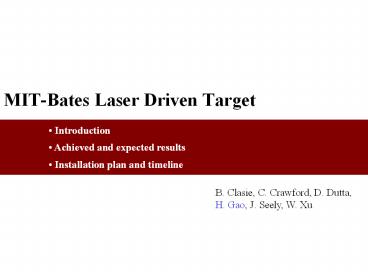MITBates Laser Driven Target - PowerPoint PPT Presentation
Title:
MITBates Laser Driven Target
Description:
LDS. ABS ... enter the polarimeter at 90 to the LDS guaranteeing target cell wall collisions ... LDS. Target cell. Electron. polarimeter. Drifilm coating ... – PowerPoint PPT presentation
Number of Views:50
Avg rating:3.0/5.0
Title: MITBates Laser Driven Target
1
MIT-Bates Laser Driven Target
- Introduction
- Achieved and expected results
- Installation plan and timeline
B. Clasie, C. Crawford, D. Dutta, H. Gao, J.
Seely, W. Xu
2
Introduction Laser Driven Target
- A circularly polarized laser is absorbed by
potassium vapor, which polarizes the potassium
(optical pumping) - The vapor is mixed with hydrogen (H) and spin is
transferred to the H electrons through
spin-exchange collisions - The H nuclei are polarized through the hyperfine
interaction during frequent H-H collisions
3
Comparison of ABS and LDS
LDS
ABS
- Advantages of the LDS for BLAST
- Higher FOM for hydrogen
- Compact design, can be installed in the low BLAST
field region - Pumping is not as critical as for the ABS
- Thicker target will reduce scattering events from
the cell wall relative to the target gas
- Disadvantages
- Thicker target and potassium vapor will reduce
the beam lifetime, ?gas 4-12min - No significant deuterium tensor polarization
- Deuterium vector polarization has not yet been
optimized - Wire chambers may trip more often
4
Current status
- This target was intended to be used in the
Precise Determination of the Proton Charge
Radius experiment (RpEX) MIT-Bates Proposal
00-02 - Polarized hydrogen is the first priority (vector
polarized deuterium can be produced) - We are currently optimizing our results for
hydrogen
The current apparatus includes a transport tube
and storage cell (or target cell) which increase
the number of wall collisions
5
LDT target cell
The LDT target cell has a small diameter,
D1.25cm (thickness ? D-3) Atoms enter the
polarimeter at 90 to the LDS guaranteeing target
cell wall collisions
Monte-Carlo simulation results for the average
number of wall collisions
6
Achieved and expected result
fa degree of dissociation Pe H electron
polariz. ? H nuclear polariz. (pz) FOM
Figure Of Merit flow??pz?2, or,
thickness ??pz?2
Measurements were made at the center sampling
hole of the target cell and without an
Electro-Optic Modulator (EOM) An EOM increases
the laser linewidth to better match the doppler
absorption profile of potassium
7
Summary of results
Hermes (ABS) 96 - 01 BLAST (ABS) (units) Gas H
D H Flow (F) 6.5 4.6 2.5 (1016 atoms/s) thicknesss
(t) 7.5 14 3.0 (1013 atoms/cm2) ?pz?
0.88 0.85 0.45 F ??pz?2 0.50 0.33 0.051 (1017
atoms/s) t ??pz?2 5.8 10.1 0.61 (1013 atoms/cm2)
E.C. Aschenauer ,International Workshop on QCD
Theory and Experiment, Martina Franca, Italy, Jun
16 - 20, 2001 HERMES target cell has elliptical
cross section 29 x 9.8 mm
IUCF (LDT) 1998 MIT (LDT) Prelim. (units) Gas H D
H Flow (F) 1.0 1.0 1.1 (1018 atoms/s) thicknesss
(t) 0.3 0.4 1.5 (1015 atoms/cm2) f?
0.48 0.48 0.56 Pe,atomic 0.37 ?pz?
0.145 0.102 F ??pz?2 0.21 0.10 0.34 (1017
atoms/s) t ??pz?2 0.63 0.42 4.7 (1013 atoms/cm2)
IUCF target cell had a rectangular cross section
32 x 13 mm
8
Installation plan and timeline
Total time required 5-6 months
More info at http//ldt.mit.edu/proton/ldt_07_31_0
3.pdf (a report by W. Xu)
9
- Target chamber
- Thin aluminum windows for BLAST acceptance
- Target cell is heated ( 220 ºC )
- ABS turbo pumps will be used and positioned
either inside or outside the BLAST toroid
- Holding field coils
- Two identical coil layers
- 700G at the spin-exchange cell
- 580G at the target cell
- Top coil will be removed during target
maintenance - Hole in center of coils allows the QMA to be
positioned below the target chamber
10
- Laser System
- Two TiSapph lasers will need to be positioned on
a laser table outside the hall - One TiSapph and Ar laser are expected to be
supplied by Bates (already exists) - The laser beams will be transported to the target
by a single fiber - Fast spin-flipping can be achieved by using
stepper motors connected to the lasers































